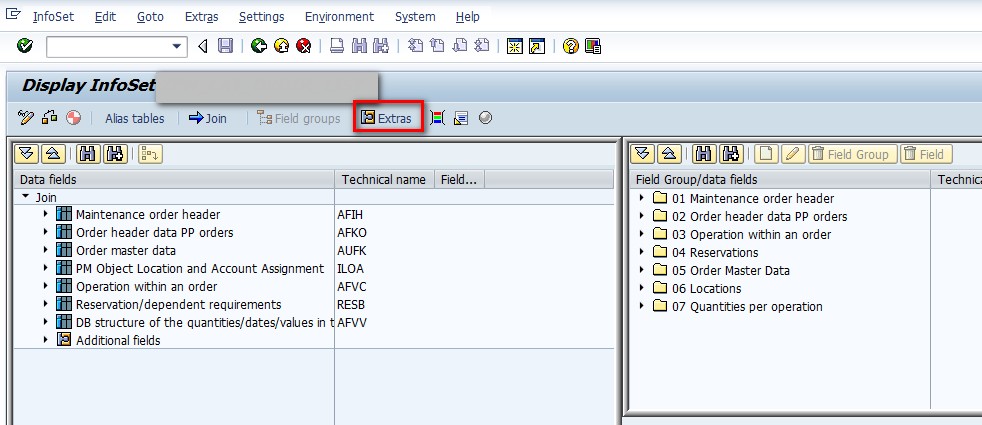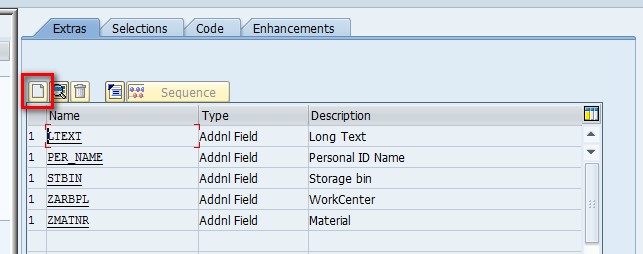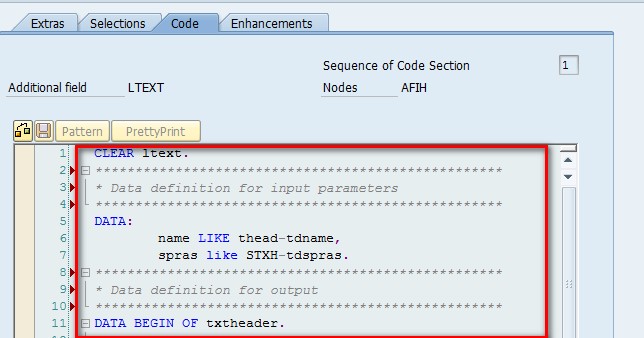
- SAP Community
- Products and Technology
- Enterprise Resource Planning
- ERP Blogs by Members
- Long Texts in Plant Maintenance - extraction
- Subscribe to RSS Feed
- Mark as New
- Mark as Read
- Bookmark
- Subscribe
- Printer Friendly Page
- Report Inappropriate Content
Introduction
As most of you know, in many objects related to plant maintenance module (technical objects as equipment, functional location but also notifications, orders, confirmations) we can fulfill long text field. The functionality itself is really nice and helpful but very painful in terms of reporting / extraction activities.
Long text reporting / extraction
We have 2 options to get long text in PM reports
1. Development done on standard reports - adding additional column(s) for long text - this activity needs to be done by developers
2. Creation of SAP query with small piece of ABAP coding inside. This is the scenario which I will describe bellow.
As the background, you should be familiar with SAP Queries functionality (SQ01, SQ02, SQ03 transactions).
Following links can be helpful:
SAP Adhoc Query SQ01 SQ02 SQ03
Using Infoset Query, SAP Query and Quick Viewer
Steps to be done:
Step 1. Create Infoset (SQ02)
I will not describe this step, as setup of tables can be different for each requirement. You should base here documents linked above.
Step 2. Create and program additional field in infoset.
In this step, you need to add new field to infoset.
From the main screen you need to navigate to 'Extras'

Than create new field ...

And define parameters for this field

From list of additional fields select the newly created one (by placing the cursor on it and 'click') and go to coding section

Here you have to place a little bit of ABAP code ...

The example code (in case of extraction long text for operation within PM order) looks like bellow.
CLEAR ltext.
***************************************************
* Data definition for input parameters
***************************************************
DATA:
name LIKE thead-tdname,
spras like STXH-tdspras.
***************************************************
* Data definition for output
***************************************************
DATA BEGIN OF txtheader.
INCLUDE STRUCTURE thead.
DATA END OF txtheader.
DATA BEGIN OF txtlines OCCURS 15.
INCLUDE STRUCTURE tline.
DATA END OF txtlines.
***************************************************
* Getting parameter 'name' which in case of operation long text
* is combination of mandant, routing number and general counter
***************************************************
CONCATENATE afvc-mandt afvc-aufpl afvc-aplzl
INTO name.
***************************************************
* Determining language which has been used for long text
* (assuming, that there is only one used :smile:
***************************************************
Select single TDspras into spras from STXH where TDOBJECT = 'AUFK'
AND TDID = 'AVOT' and TDNAME = name.
***************************************************
* Reading long text into internal table
***************************************************
CALL FUNCTION 'READ_TEXT'
EXPORTING
client = sy-mandt
id = 'AVOT'
language = SPRAS
name = name
object = 'AUFK'
archive_handle = 0
* LOCAL_CAT = ' '
IMPORTING
header = txtheader
TABLES
lines = txtlines
EXCEPTIONS
id = 1
language = 2
name = 3
not_found = 4
object = 5
reference_check = 6
wrong_access_to_archive = 7
OTHERS = 8.
IF sy-subrc <> 0.
* Implement suitable error handling here
ENDIF.
***************************************************
* Concatenating long text rows from internal table
* into one, output field
***************************************************
LOOP AT txtlines.
CONCATENATE ltext txtlines-tdline INTO ltext SEPARATED BY space.
ENDLOOP.
REFRESH txtlines.
As you can see, they work is done by function module READ_TEXT.
At the end of this post I will describe the way how to get feeding parameters for this FM in case of different reference objects for Long Text.
Step 3. Add new field to fields group.
This action is as for the standard fields. Basically you will see newly created field in catalog on the left side of the screen and you need to add this field to one of the catalogs which will be visible in Query. Use drag&drop technique ...

Step 4. Assign infoset to user group (SQ03 or SQ02)
Step 5. Create Query based on newly created infoset (SQ01)
Step 6. Enjoy ....
In the order we have:

And in Query :

Parameters for FM READ_TEXT
To get the parameters for function module, while being in long text editor please choose following path.

All 3 parameters marked bellow will be different for different reference object of long text.
Parameters in red are describing type of object (AUFK - Orders, AVOT - operations in order).
Text name (In yellow) is identifying single long text segment (in this case single operation). This field is tricky one and in fact you have to resolve the quiz how it's build (sometimes it's easy - ex. are materials or equipments, sometimes more complicated ...)

Example for equipment long text (text name is pure equipment number with leading zeroes)

And ... That's All Folks !!!
Hope it will help you a little bit with long text reporting & extraction.
Remarks:
I'm not ABAP consultant, so for sure this piece of code is not optimized and could be done in better way
In case of really long long texts you can face some issues due to capacity of ALV field (I think, it can contain up to 255 characters. In this case maybe you will need to split long text into 2 display fields (each for 255 characters)
heniek
- SAP Managed Tags:
- PLM Enterprise Asset Management (EAM)/Plant Maintenance (PM)
You must be a registered user to add a comment. If you've already registered, sign in. Otherwise, register and sign in.
-
"mm02"
1 -
A_PurchaseOrderItem additional fields
1 -
ABAP
1 -
ABAP Extensibility
1 -
ACCOSTRATE
1 -
ACDOCP
1 -
Adding your country in SPRO - Project Administration
1 -
Advance Return Management
1 -
AI and RPA in SAP Upgrades
1 -
Approval Workflows
1 -
ARM
1 -
ASN
1 -
Asset Management
1 -
Associations in CDS Views
1 -
auditlog
1 -
Authorization
1 -
Availability date
1 -
Azure Center for SAP Solutions
1 -
AzureSentinel
2 -
Bank
1 -
BAPI_SALESORDER_CREATEFROMDAT2
1 -
BRF+
1 -
BRFPLUS
1 -
Bundled Cloud Services
1 -
business participation
1 -
Business Processes
1 -
CAPM
1 -
Carbon
1 -
Cental Finance
1 -
CFIN
1 -
CFIN Document Splitting
1 -
Cloud ALM
1 -
Cloud Integration
1 -
condition contract management
1 -
Connection - The default connection string cannot be used.
1 -
Custom Table Creation
1 -
Customer Screen in Production Order
1 -
Data Quality Management
1 -
Date required
1 -
Decisions
1 -
desafios4hana
1 -
Developing with SAP Integration Suite
1 -
Direct Outbound Delivery
1 -
DMOVE2S4
1 -
EAM
1 -
EDI
2 -
EDI 850
1 -
EDI 856
1 -
edocument
1 -
EHS Product Structure
1 -
Emergency Access Management
1 -
Energy
1 -
EPC
1 -
Financial Operations
1 -
Find
1 -
FINSSKF
1 -
Fiori
1 -
Flexible Workflow
1 -
Gas
1 -
Gen AI enabled SAP Upgrades
1 -
General
1 -
generate_xlsx_file
1 -
Getting Started
1 -
HomogeneousDMO
1 -
IDOC
2 -
Integration
1 -
Learning Content
2 -
LogicApps
2 -
low touchproject
1 -
Maintenance
1 -
management
1 -
Material creation
1 -
Material Management
1 -
MD04
1 -
MD61
1 -
methodology
1 -
Microsoft
2 -
MicrosoftSentinel
2 -
Migration
1 -
MRP
1 -
MS Teams
2 -
MT940
1 -
Newcomer
1 -
Notifications
1 -
Oil
1 -
open connectors
1 -
Order Change Log
1 -
ORDERS
2 -
OSS Note 390635
1 -
outbound delivery
1 -
outsourcing
1 -
PCE
1 -
Permit to Work
1 -
PIR Consumption Mode
1 -
PIR's
1 -
PIRs
1 -
PIRs Consumption
1 -
PIRs Reduction
1 -
Plan Independent Requirement
1 -
Premium Plus
1 -
pricing
1 -
Primavera P6
1 -
Process Excellence
1 -
Process Management
1 -
Process Order Change Log
1 -
Process purchase requisitions
1 -
Product Information
1 -
Production Order Change Log
1 -
Purchase requisition
1 -
Purchasing Lead Time
1 -
Redwood for SAP Job execution Setup
1 -
RISE with SAP
1 -
RisewithSAP
1 -
Rizing
1 -
S4 Cost Center Planning
1 -
S4 HANA
1 -
S4HANA
3 -
Sales and Distribution
1 -
Sales Commission
1 -
sales order
1 -
SAP
2 -
SAP Best Practices
1 -
SAP Build
1 -
SAP Build apps
1 -
SAP Cloud ALM
1 -
SAP Data Quality Management
1 -
SAP Maintenance resource scheduling
2 -
SAP Note 390635
1 -
SAP S4HANA
2 -
SAP S4HANA Cloud private edition
1 -
SAP Upgrade Automation
1 -
SAP WCM
1 -
SAP Work Clearance Management
1 -
Schedule Agreement
1 -
SDM
1 -
security
2 -
Settlement Management
1 -
soar
2 -
SSIS
1 -
SU01
1 -
SUM2.0SP17
1 -
SUMDMO
1 -
Teams
2 -
User Administration
1 -
User Participation
1 -
Utilities
1 -
va01
1 -
vendor
1 -
vl01n
1 -
vl02n
1 -
WCM
1 -
X12 850
1 -
xlsx_file_abap
1 -
YTD|MTD|QTD in CDs views using Date Function
1
- « Previous
- Next »
- No authorization to create tasklist for plant (general maintenance) in Enterprise Resource Planning Q&A
- Enterprise Portfolio and Project Management in SAP S/4HANA Cloud, Private Edition 2023 FPS1 in Enterprise Resource Planning Blogs by SAP
- Unable to add 'notification item' using BADI NOTIF_EVENT_SAVE in Enterprise Resource Planning Q&A
- The Role of SAP Business AI in the Chemical Industry. Overview in Enterprise Resource Planning Blogs by SAP
- Boost SCM Efficiency: Mat. Shelf Life Mgmt App Empowers Intelligent Decision-Making for Enterprises in Enterprise Resource Planning Blogs by SAP
| User | Count |
|---|---|
| 6 | |
| 2 | |
| 2 | |
| 2 | |
| 2 | |
| 2 | |
| 1 | |
| 1 | |
| 1 |